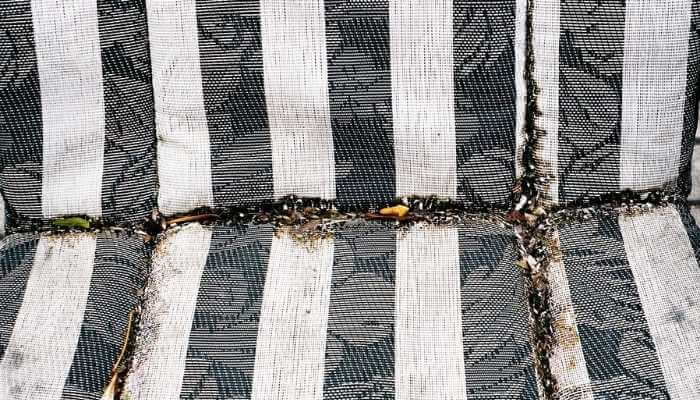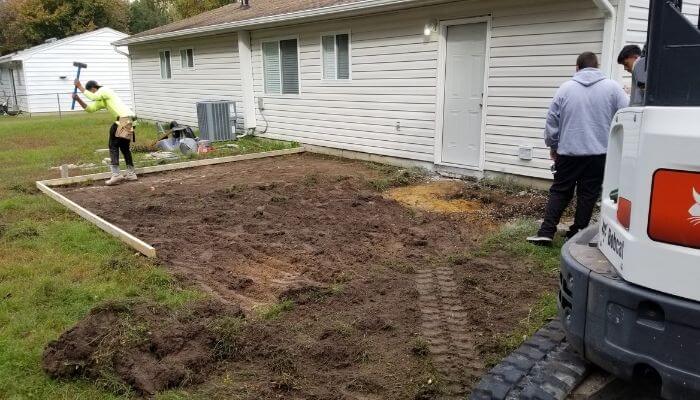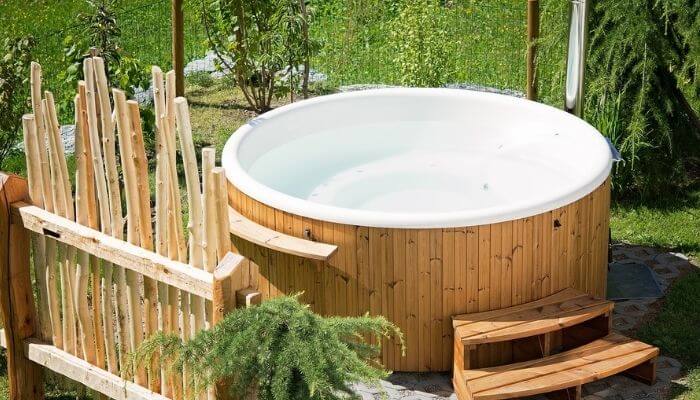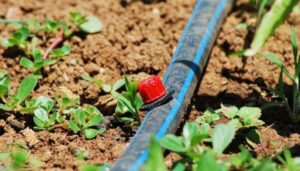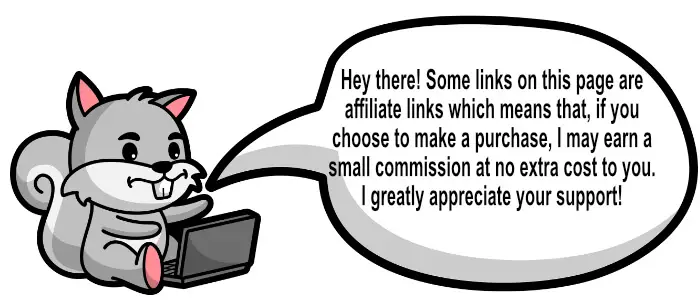
Do you want to know more about using a pressure washer? Do you wonder if it’s worth the expense to purchase one? My husband and I had the same thoughts before buying ours. I feel like sharing what we learned might help you make a decision.
A pressure washer is used to clean any outside surface that is dirty. Whether the surface has dried in mud, grease, mold, mildew, algae, or staining from trees and plants, a pressure washer used correctly and with the correct mixtures can clean your surface.
But how should you use a pressure washer if you’re unfamiliar with it? And how do you get rid of those specific stains on various surfaces? Each one is different, right? Yes. And I will touch on as many as I can in this article.
I want you to be confident in your actions, so keep reading.
What Kinds of Pressure Washers Are There?



The pressure washer we purchased is 1800 psi and electric explicitly made for residential or consumer use. It only cost us $120 from Lowe’s Home Improvement in 2015 and is still working.
You can spend more money, after all, pressure washers are made for both consumer jobs and professional services. Let’s keep it low-end, shall we?
An excellent option for an electric pressure washer would be the Greenworks 2000 PSI 1.2 GPM Pressure Washer.
You can also purchase gas-powered pressure washers. We had plenty of outdoor plugs when we made our purchase, so we didn’t see a need for gas-powered ones. However, the home we just purchased does not have outdoor plugs (early 70s home), and I can see the issue. This is up to you and what you need in your outdoor space.
Both of these consumer model types run, on average, about $100 – $300, and their psi (pound-force per square inch) is under 2000. Do you need anything more powerful? Probably not. Think about it this way:
| DEVICE | STANDARD PSI |
|---|---|
| medium-powered pressure washer | 2800 |
| standard garden hose | 60 |
| fire hose | 100-150 |
That being said, please take every precaution not to point your nozzle at any living thing, not yourself, your clothes/shoes while wearing them, plants, animals, and no… not even your nosey neighbor. These things can cause severe damage. Most manufacturers even warn you to use safety goggles while operating a pressure washer.
Are Power Washers and Pressure Washers the Same?
The terms “power washing” and “pressure washing” are often used interchangeably. So let’s be clear about the difference between the two. Even though both use water under high pressure to clean surfaces, power washers have a heating element to heat the water before it’s forced through the nozzle. Pressure washers do not heat the high-pressure water being used.
Though steam cleaning can be very efficient in some cases, using a power washer on masonry or concrete can cause more damage than necessary. That’s why I chose a pressure washer when I had the choice as a consumer.
How Does a Pressure Washer Work?

A pressure washer is attached to a power source, which pushes power into a pump. It is also connected via a hose to a water source (mine to a garden hose, professionals usually use a portable tank). The pump pressurizes the water before sending it out through a smaller opening, usually in a wand.
The wand will usually have various interchangeable tips that allow you to change the shape of the water being forced through. The angle of the spray determines how hard the water will hit a surface you are cleaning. Our pressure washer came with a color-coded guide for choosing the right tip.
What Kind of Solutions Can Be Run Through a Pressure Washer?
You can use pretty much any liquid detergent you want through your washer. Most pressure washers will have a siphoning hose from a small tank that allows you to add a cleaning solution of your choice. There are also brands of detergent specifically made to be used in pressure washers.
In case you don’t need it, there should also be a cut-off valve to bypass the soap.
One example of why you would use cleaning solutions through a pressure washer is cleaning embedded plant residue from wood – particularly wooden fencing. When we owned our first home and had a fence built in the back, I paid a professional over $800 to clean it before he stained it.
More recently, at a new home, I used our $120 washer, a $15 container of deck cleaner, and a day of my time to accomplish the same thing. That’s quite a savings if you have the time.
Stick to purchasing solutions made specifically for the area you plan to clean with your pressure washer. There’s a difference in what you would use on siding versus a wooden deck or fence. And remember to run clean water through the tank and hose after to get all the cleansers out.
What Can I Clean with My Pressure Washer?
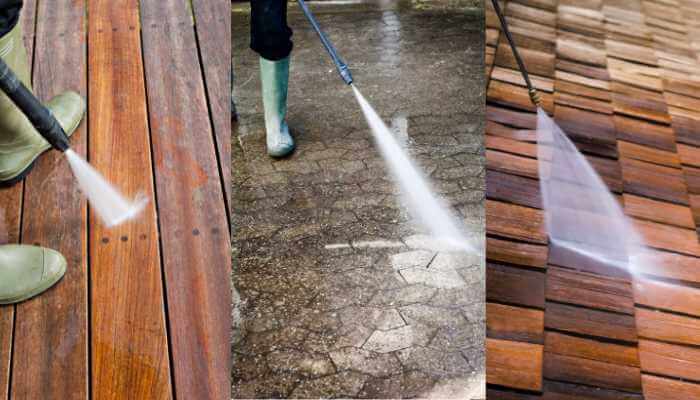
Painted furniture, fencing, and even heavier pots and planters, painted surfaces can get a good cleaning with lower-pressure tips and power. I also began using this pressure and the 40-degree tip on the house siding. It got the job done, for the most part, leaving only a few tricky spots for higher pressure and using a cleaning solution.
Moving up to medium pressure and an appropriately angled tip, you can clean things that need more power, like the undercarriage of lawnmowers, caked-on mud from beneath fenders, and decking or unpainted wood and fencing. I used the 25-degree tip and this medium pressure for the tougher spots on my vinyl siding. I tested it first before using that force.
I use the highest pressure and the 15-degree spray tip for my concrete. I used it at our residence in Chapel Hill because of the tree litter. We were under pines, oaks, and maples, so there was so much staining! But this high pressure got most of the staining out, with no cleaning solution.
Can You Cause Damage by Pressure Washing?
Don’t pressure-wash anything living, whether people, animals, or plants. If pressure-washing near plant beds, use coverings to keep the spray from damaging your plants. This is high-velocity water, and it can definitely damage things.
A pressure washer may be perfect for the job if your concrete is poured. Don’t hold the nozzle too close, choose the correct spray tip, and don’t let the power harm your concrete (or anything else, for that matter). Most damage to surfaces comes from choosing the incorrect tip.
Start with the “walk-up” method. Use the widest tip first and keep the wand at least 2 feet from the object you want to clean. Choose an inconspicuous spot to test on. Move forward until you get a good idea about the cleaning power of this particular tip.
If it’s not giving you enough, work to smaller tips until you get the one you need. If it’s too harsh and the pressure too much, at least you used it on a hidden area.
When Would You Not Use a Pressure Washer?

But if your patio is made with concrete pavers or you have a special coating on your concrete, the pressure washer can cause problems. A pressure washer can remove the sealant or the coating from things. And where pavers are concerned, it can remove the binding agent between them, leaving them unstable.
Be careful about ANY painted surface. It takes practice and finesse to clean these surfaces with a pressure washer and not remove the paint. I know that for me, the “walk-up” method was the way to go. This goes for stained wood, too. If you use a pressure washer on it, you may need to restrain it.
A pressure washer can groove anything made of sandstone and limestone. A pressure washer can literally wind up blasting the limestone surface right off. This leaves the inner layers susceptible to erosion. You either have to be very good at it or don’t do it.
If it were up to me and I put money into something made with softer stones? I would not use the pressure washer on it.
As tempting as it is to pressure wash a roof, know that you could cause damage when you do it. Pressure washing can remove the very granules from roofing tiles that lend them their protection.
Also, my general rule of thumb is if I could clean something by hand quicker than setting up the pressure washer – I do it by hand. That’s just saving time and energy.
In Conclusion
Do you buy a pressure washer or not? If you already have one, did I guide you on how to use it? Do you have some suggestions for me? If you don’t have one but need to clean some concrete, check out my article that covers The Best Ways to Clean your Concrete Patio. Watch for more articles to come!



